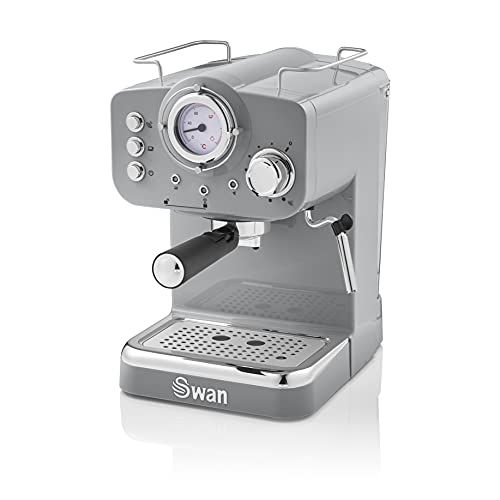Espresso Maker - A Must-Have For Home Baristas
Espresso is a strong dark-brown drink that is created by pushing hot water through finely packed, tightly ground coffee. It is the base of many popular cafe drinks.
A skilled barista (also called an espresso maker) controls a number of variables to make a great cup of espresso. This includes the temperature of the water, its pressure, and how tightly packed the coffee is.
Origins
The espresso maker is a machine that pushes small amounts of near boiling water under a high pressure through coffee beans that have been finely ground. The espresso is stronger than the other coffees and served in smaller cups. This is a great option for those who want a strong cup of espresso but need it fast!
In the 19th century the first espresso machines were invented. The coffee industry was a huge industry, but brewing it took way too long. People everywhere were hungry for an instant cup!
Angelo Moriondo of Turin patented one of the first coffee machines in 1884. The name of the machine was "New steam machinery, for the efficient and quick preparation of coffee beverage. Method A." Moriondo."
Luigi Bezzerra, Desiderio Pavoni and other Milanese manufacturers improved and adapted this machine. They introduced the portafilter, numerous brewheads as well being other inventions that are still associated with espresso makers today. 9 bar espresso machine was called Ideale and it wowed audiences at the 1906 Milan Fair. Nine out of 10 Italian homes have Moka Pots. Moka Pot.
Variations
Espresso is more intense in flavor than coffee. It is a great match with milk and creates café drinks like lattes or cappuccinos. Its strong flavor is evident in baked goods recipes, marinades and other dishes.
There are four types of espresso maker including manual levers semi-automatic and automatic and super-automatic machines. Each type uses a different method of extracting the espresso.
A manual lever machine uses an electric piston that pushes water through the ground. It's a great alternative to the human hand and mechanized consistency. You'll still have the grind and tamp shot but you can manage water temperature and pressure much better.
Moka pots are yet another manual espresso maker that functions similar to modern pump-driven espresso machine. In an airtight container, boiling water, steam is created. This steam is then transported into a basket containing ground coffee, then through an iron filter into the top cup. These machines are more affordable, however they can only create 1-1.5 bars of steam pressure. This isn't enough to make espresso.
Ingredients

With a little effort and practice, espresso makers can help baristas at home make cafe-style drinks like cappuccinos, lattes and flat whites. You can also add flavorful syrups or extracts to espresso shots for an indulgence like the espresso martini.
To enjoy a delicious espresso drink you'll need high-end beans, fresh milk, and sugar. To ensure an even extraction, look for coffee beans that bear a special espresso label. Grind them finely. You can experiment with various roasts until you discover the one you prefer the most.
There is also a burr grinder, which grinds the beans into a consistent texture. The espresso machine comes with a portafilter, which stores the grounds, as well as the tamper, which is used to pack the coffee tightly.
You'll also need an espresso cup set, as well as a steamer to make the silky aerated-milk the hallmark of espresso drinks. Certain machines have a steam wand built in which makes this process much easier and speedier. You'll also have to regularly clean the machine, which involves running an acidic solution of vinegar and water through the system.
Techniques
Espresso brewing relies upon creating pressure that allows for rapid extraction of intense flavors from finely ground dark-roast, dark-roast brewed coffee packed into a "puck." This method of brewing creates the strong coffee shot referred to as espresso. When made well espresso is a delicious crema (or dense foam) on top.
In contrast to the Moka Express that uses heat to filter water through coarsely ground coffee, most espresso makers make use of highly pressurized water that is forced through small grounds using high heat. This makes an espresso-like drink that can be blended by milk or water to create other beverages such as lattes and cappuccinos.
While the Moka Express is a simple, low-cost appliance, other espresso machines are complicated expensive, and offer an array of beverage options. The most well-known, however, are the Italian-designed levers that use spring-loaded arms that release hot water from a cylinder to the portafilter. A barista using such a machine can control when to pull the shot, adjusting variables such as the size of the grind and the temperature of the water by shot to achieve the best results. These machines were instrumental in bringing espresso into greater recognition throughout Italy and Europe.
Equipment
A good espresso machine must be able to extract both soluble and non-soluble solids from finely roasted, tightly packed coffee. This is made possible by the use of pressure and controlled variables such as temperature and grind size. The flavor is also the result of a variety of factors such as the beans used and how they are produced.
There are several types of machines that produce espresso however the most popular is the semiautomatic machine. It utilizes an electric motor to move the water around and push it through the grounds. The user is also able to do the grinding and tapping. These machines are the most affordable, but they're not as reliable as spring pistons or other designs that are manual.
The higher priced lever models have a calibrated piston that does the work for you. They're a bit more flexible than a spring piston machine however, they require some experience to use correctly. They typically require some maintenance, and require you to heat and de-assemble the portafilter and the piston each time.
